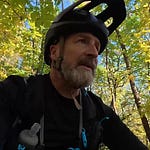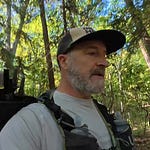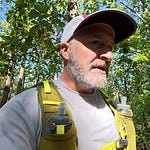The Breaking Point
Four hours in, with just over 20K behind me, my body was sending clear signals. The mangoes I'd finally remembered to grab at my car were still working their way into my system—too little, too late. As I shuffled forward, watching my heart rate climb steadily into mid-Zone 3 despite my best efforts to dial it back.
"Calling an audible." The ambitious 30K plan would have to wait for another day. Today would be about respecting limits and making it back without bonking completely.
The Morning Mission
I'd set out early with a flexible goal: at least 25K, possibly stretching to 30K, depending on how the day unfolded. Mid-40s temperature with some wind in the forecast, but nothing too threatening as I started my Saturday long run. I was using my Camelback UltraVest—the same one I'd used for last year's 50K—but with an addition: a pole quiver holding my brand-new Leki carbon poles.
These poles weren't just any purchase. Being carbon, I'm almost too protective of them, saving them only for situations where "light and fast" was the priority. For everyday training, my aluminum Black Diamonds would do the job. But today was about preparation and simulating race conditions for the upcoming 50K.
The Environmental Equation
The trails presented their usual collection of challenges. Sandy sections that sapped momentum, steep climbs that demanded respect, and just enough wind to remind you it was there. The forest provided welcome shelter in most sections, creating pockets of stillness that made the exposed ridgelines all the more noticeable when I reached them.
I clicked through the first 5K in 45 minutes and change, immediately noticing differences with the new poles. The extra five centimeters (about two inches) I'd opted for created a more favorable angle on hills, giving me increased leverage that my shoulders quickly recognized. It had been months since I'd used poles consistently—they were earning their keep today.
The Mental Game
The second 5K passed in 42 minutes. A bit faster at 4.2 miles per hour, with my legs beginning to feel the accumulation of hills. The third 5K: another 45 minutes, still moving steadily. I had my Huberman podcast playing—Pavel Tsatsouline providing a mental distraction from the growing fatigue.
Twelve miles in, I realized my first mistake. The mangoes I'd planned to grab after the first 10K remained in my car. I was operating on empty, with nothing but diluted Magna electrolytes (testing these instead of my usual LMNT), providing minimal sustenance. Despite the stomach-friendly nature of the new electrolyte mix, the missing calories were starting to matter.
The Turning Point
Reality was setting in by the fourth 5K (49 minutes, noticeably slower). The initial optimism of "I think I'll do the 30K today" faded against the practical evidence my body was providing. My heart rate was creeping up even when I dropped to a shuffle, and simple math told the story: at my current pace, 30K would push me closer to five hours than the four I'd mentally prepared for.
"I think 25K will be about four hours on feet," I reasoned aloud, finally deciding to adjust my plan. The mangoes I'd finally remembered were now in my system, but they needed another 20-30 minutes to provide energy—essentially the remainder of my run. The wind had picked up considerably. Validating my decision to avoid the exposed ridge section after 25K. Walking became the only option to keep my heart rate reasonable. I realized I had crossed the line from "desirable difficulty" to "fighting a losing battle."
The Finish Line
That final 5K took 50 minutes and change, confirming I'd made the right call. I crested the last steep hill, grateful for the surprisingly sunny conditions that had defied the forecast, and made my way back to the car.
The Real-World Results
The test run revealed practical insights beyond mere numbers. The Leki poles performed well, though I couldn't shake my nervousness about potentially breaking these expensive carbon sticks. The "shark grip" (or "shark bite"—I can never remember which) handles were comfortable, though they stopped my watch on one occasion, causing me to reposition the watch a bit further up my forearm.
Most definitively, my shuffling running style combined with the Olympus shoes led to one clear conclusion: Gators are non-negotiable from now on.
And those mangoes? Lesson learned. When I finally got to them, they tasted almost supernaturally sweet—plain, dried, unsulfured fruit that delivered exactly what my depleted body needed, just a bit too late in the game. Next time, I'll keep them accessible from the start or make that planned stop non-optional.
Tomorrow brings another challenge—at least a 15K hike, possibly with a ruck if my legs recover sufficiently overnight. But first, there's a burger with my name on it. After four hours on the trails, I've earned it.
Final Stats
Here's the breakdown for those keeping score:
Distance: 16.44 miles
Time: 4:08:50
Average Pace: 15:08/mile
Heart Rate: Avg 152 bpm
Elevation Gain: 2,100 feet
Heart Rate Zones:
Zone 1: 11% (≈28 minutes)
Zone 2: 68% (≈2 hours, 50 minutes)
Zone 3: 19% (≈48 minutes)
Training Effect: 4.2 aerobic, 0.3 anaerobic
Training Status: Productive
Recovery Time: 40 hours











